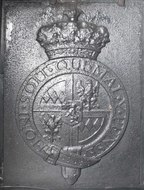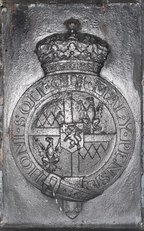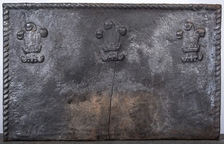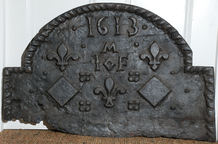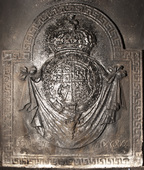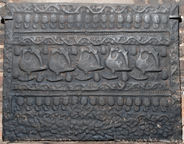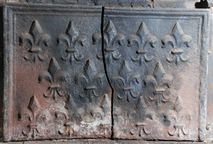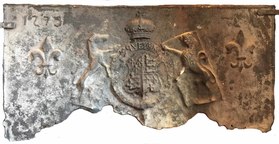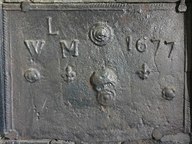-
1217
Description: Rectangular shape; no edging; shield of the 2nd Duke of Montagu surrounded by the Garter and surmounted by a ducal coronet.
Notes: One of 23 firebacks at Boughton House, Northamptonshire, cast with the ducal arms and the Garter having a diameter of 48cm. Fifty firebacks were cast for the house between 1743 and 1748 by Richard Ford, probably at Nibthwaite Furnace, but also possibly at Newland furnace, both then in north Lancashire. The arms are blazoned: Quarterly, 1st & 4th: Argent, three fusils conjoined in fess gules, a bordure sable (Montagu); 2nd & 3rd: Or an eagle displayed vert beaked and membered gules (Monthermer); on an escutcheon of pretence, Sable a lion rampant Argent a canton Argent charged with a cross Gules (Churchill); John, 2nd Duke of Montagu married Mary, daughter and co-heiress of John, 1st Duke of Marlborough.
Copies of this fireback are known.
Inscription: HONI.SOIT.QUI.MAL.Y.PENSE
Arms: Montagu quartering Monthermer with Churchill in an escutcheon of pretence - John Montagu, 2nd Duke of Montagu, KG
- Decoration tags:
- rectangular (shape)
- none (edging)
- carved pattern panels
- heraldic
- armorial
- text
Manufactured: in the mid-18th century probably at Newland Furnace in the Furness area of England.
Current location: Boughton House, Geddington, Northamptonshire, England.
- Attached to series:
- Montagu arms series
- Personal armorial firebacks
-
1218
Description: Rectangular shape; no edging; shield of the 2nd Duke of Montagu surrounded by the Garter and surmounted by a ducal coronet.
Notes: One of five firebacks at Boughton House, Northamptonshire, cast with the ducal arms and the Garter having a diameter of 59cm. Fifty firebacks were cast for the house between 1743 and 1748 by Richard Ford, probably at Nibthwaite Furnace, but also possibly at Newland furnace, both then in north Lancashire. The arms are blazoned: Quarterly, 1st & 4th: Argent, three fusils conjoined in fess gules, a bordure sable (Montagu); 2nd & 3rd: Or an eagle displayed vert beaked and membered gules (Monthermer); on an escutcheon of pretence, Sable a lion rampant Argent a canton Argent charged with a cross Gules (Churchill); John, 2nd Duke of Montagu married Mary, daughter and co-heiress of John, 1st Duke of Marlborough.
Copies of this fireback are known.
Inscription: HONI.SOIT.QUI.MAL.Y.PENSE
Arms: Montagu quartering Monthermer with Churchill in an escutcheon of pretence - John Montagu, 2nd Duke of Montagu, KG
- Decoration tags:
- rectangular (shape)
- none (edging)
- carved pattern panels
- heraldic
- armorial
- text
Manufactured: in the mid-18th century probably at Newland Furnace in the Furness area of England.
Current location: Boughton House, Geddington, Northamptonshire, England.
- Attached to series:
- Montagu arms series
- Personal armorial firebacks
-
1019
Description: Rectangular; twisted rope edging; top centre and corners, stamp formed of three ostrich feathers within a coronet, repeated three times.
Notes: The ostrich feathers are the badge of the Prince of Wales; a recast plate. Gildings Auctioneers, Market Harborough, 19 Apr 2016 lot 529.
- Decoration tags:
- rectangular (shape)
- rope (edging)
- carved stamps
- heraldic
- royal
- objects
Manufactured: in the early- to mid-17th century in England.
Current location: not known.
- Attached to series:
- Prince of Wales' feathers series
- Prince of Wales firebacks
-
70
Description: Arched rectangular shape; simulated twisted rope edging (top & sides); symmetrical arrangement of fleurs de lys (two types - 2 and 1), diamond shapes (2) and cross-cut squares (4) includes the monogram in which the letters I and F are separated by a small, hollow diamond stamp, the M being above; interspersed symmetrical arrangement of raised spots (8).
Notes: The initials, as with other triple-lettered forms, in which the middle letter is set apart from the other two, may relate to a married couple where their surname initial is M. Another example seen has shown that the pattern was formed of five angular, uneven-sized planks battened together.
Copies of this fireback are known.
Inscription: 1613 / M / I F
- Decoration tags:
- rectangular with round arch (shape)
- simulated rope (edging)
- simple stamps
- carved stamps
- individual letters
- individual numbers
- planklines
- heraldic
- text
Manufactured: in 1613 in the Weald area of England.
Current location: Godalming Museum, Godalming, Surrey, England.
Museum number: B980.400 (part of the Godalming Museum museum group)
- Attached to series:
- Diamond series
-
1292
Description: Arched rectangular shape; Greek Key border with fillet edges; in high relief, in front of swagged drapery, the shield of, quarterly, France quartering England, Scotland and Ireland, surrounded by a Garter, and surmounted by a ducal coronet; below, the inscription in capitals.
Notes: The use of the Greek Key design as a border is believed to be unique for an English fireback. Although somewhat indistinct, the use of the Stuart royal arms and the ducal coronet can be explained by the fact that the fireback was one of a group cast for the 2nd Duke of Richmond, whose father, the 1st duke, was the illegitimate son of Charles II and Louise de Kéroualle. The Richmond arms were differenced from the Stuart royal arms by the addition of a bordure compony (the detail of which is not distinct on this casting). Sowley Furnace, near Beaulieu in Hampshire, was owned in 1732 by John, 2nd Duke of Montagu, and was let to Miles Troughton. An identical fireback also at Goodwood is dated 1731 and a similar, but smaller, variant of this fireback, is dated 1732.
Copies of this fireback are known.
Inscription: HONI SOIT QUI MAL Y PENSE / SOWLEY MDCCXXX
Arms: Duke of Richmond
- Decoration tags:
- rectangular with round arch (shape)
- fillet (edging)
- whole carved pattern
- heraldic
- armorial
- royal
- text
Manufactured: in 1730 at Sowley Furnace, Beaulieu in the New Forest area of England.
Current location: Goodwood House, Westhampnett, West Sussex, England.
-
1207
Description: Rectangular; twisted rope edging (top and sides); in the upper part of the plate, between a leopard passant guardant sinister (on the left) and a leopard passant (on the right), a domed roundel bearing an off-centre smaller roundel within an edged circular depression, repeated four times in diamond pattern, with the smaller roundels orientated towards the centre of the arrangement; in the top corners, two more domed roundels, their smaller roundels orientated towards the bottom of the plate.
Notes: The roundel stamp has not been noted on any other firebacks. One of the legs of the leopard on the left and both legs of the leopard on the right are missing, suggesting that the stamps, which appear complete on many firebacks, were well used and had been damaged; this suggests a relatively late use of these stamps. Gorringe's auction, Lewes, lot 82, 2 Aug 2021 (£170). Bishop & Miller Auctioneers, Stowmarket, 27 Jan 2022, lot 383 (£2,900).
Copies of this fireback are known.
- Decoration tags:
- rectangular (shape)
- rope (edging)
- simple stamps
- carved stamps
- heraldic
- animals
- objects
Manufactured: in the mid- to late-16th century in the Weald area of England.
Current location: not known.
- Attached to series:
- Royal series
-
996
Description: Quasi-rectangular shape (42.5mm wider at the bottom); border formed of strips carved with an undulating vine (top and sides); successive rows of repeated stamps: (from top) 18 'hops' or 'grape bunches' in line, horizontal fillet with line of beads below, line of vine strips, 5 birds (probably swans, a Lancastrian badge) in line with 'hops'/'grape bunches' at top and bottom of gaps, line of vine strips, line of beads with horizontal fillet below, 17 'hops'/'grape bunches' in line, and line of vine strips (partially obscured by what appears to be the repeated pressing of finger tips into the casting sand to form an extension at the base).
Notes: One of a series of firebacks incorporating the use of the undulating vine strip, and the 'swan' stamp. This may be a recasting produced by the firm of Charles Wayte & Cheverton, formerly of Edenbridge, Kent, as a similar back was illustrated in their catalogue.
- Decoration tags:
- rectangular (shape)
- trailing vine (edging)
- simple stamps
- carved stamps
- heraldic
- animals
- plants
- objects
Manufactured: in the late-16th century possibly at Pounsley Furnace, Framfield in the Weald area of England.
Current location: in private hands, Goudhurst, Kent, England.
- Attached to series:
- Pounsley series
- Vine strip series
- Swan series
- Furniture stamp firebacks
-
75
Description: Rectangular; ovolo moulded edging (top and sides); 14 impressions of a fleur de lys, arranged in three horizontal rows (5-4-5), carefully spaced.
Notes: The same fleur de lys stamp has been noted on several firebacks, indicating a common source.
- Decoration tags:
- rectangular (shape)
- ovolo (edging)
- carved stamps
- heraldic
Manufactured: in the mid- to late-16th century possibly at Pounsley Furnace, Framfield in the Weald area of England.
Current location: in private hands, Groombridge, East Sussex, England.
- Attached to series:
- Pounsley series
-
1226
Description: Rectangular; rope edging (top & sides); in centre, Tudor shield, garter, crown and supporters (greyhound and lion) between two fleurs-de-lys; date top left.
Notes: A badly corroded fireback. The armorial achievement is seen on other firebacks and was formed from four separate stamps; the supporters are consistent with the date; the style of the numerals is uncharacteristic of the period. The sharpness of the detail on the crown and upper part of the Garter indicates that the fireback is contemporary with the date, and not older as similar examples seem to be. The same date in identical form is on a similar fireback at Penshurst Place, Kent.
Inscription: 1579 / [Garter motto incomplete]
Arms: Tudor royal
- Decoration tags:
- rectangular (shape)
- rope (edging)
- carved stamps
- date stamp
- heraldic
- armorial
- text
- animals
Manufactured: in 1579 in the Weald area of England.
Current location: Groombridge Place, Speldhurst, Kent, England.
- Attached to series:
- Tudor redated series
- Pounsley series
- Tudor royal armorial firebacks
-
306
Description: Rectangular; twisted rope edging (top and sides) with a fillet inside; top centre, concentric roundel with rose-and-crown below; top left, initials in triad with small rose below 'W' and small fleur-de-lys below 'M'; upper right, date with small fleur below '6' and small rose lower, below second '7'.
Notes: The style of rose and crown is similar to that used in gun founding in the Tudor period, suggesting that the furnace that was the source of this fireback may have been used for that purpose.
Inscription: WLM [triad] 1677
- Decoration tags:
- rectangular (shape)
- rope (edging)
- carved stamps
- individual letters
- individual numbers
- heraldic
- text
- objects
Manufactured: in 1677 in the Weald area of England.
Current location: in private hands, Speldhurst, Kent, England.
- Attached to series:
- 1660s-90s Wealden series
- Date & initials firebacks
